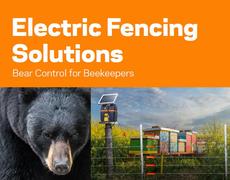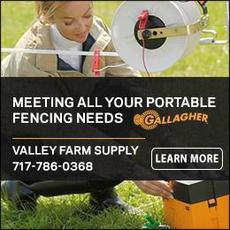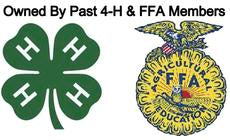
Farm fencing acts to keep livestock confined to a certain area, to keep predators at bay or both. Finding the style of fence that fits your specific needs and budget while providing efficient livestock management is a priority on any farm.
“Containment is the major consideration, especially to ensure the safety of the farm animal from getting caught up in the fencing,” said Carrie Chickering-Sears, director of community education in animal agriculture at the University of Massachusetts, Amherst. “Keeping predators out is another factor, though no fencing will keep out an animal that wants a meal. Aesthetics is another, depending upon the look the farmer wants for his or her property.”

According to Carrie Chickering-Sears, pigs can be a challenge when pasturing, but woven wire is a good choice.
Photo courtesy of Large Black Pigs of Maine, Farmington, Maine.
Mind and matter
Fences are typically thought of as physical barriers, preventing or at least inhibiting access to and from a given area. However, some fences can present no real physical barrier yet keep an animal contained. A pile of brush or stones can keep some livestock from wandering away. In some cases, a small ditch, a river or a steep slope can serve as a natural fence. They could be forded or climbed, but the animals aren’t normally inclined to do so.
Today, electric fences serve the same purpose. They may not be strong enough to physically prevent an animal from going through the fence, but the electric charge is painful, and once animals figure that out, they tend to avoid the sensation. Barbed wire fences can also be breached, but the pain inflicted should stop any attempts to do so.
Fences that are physically able to keep animals at bay are typically used for perimeter fencing, holding pens, handling areas and other situations where a strong, secure barrier is required. Wooden mesh wire, woven wire and steel pipe fencing can serve as physical barriers.
“Cattle do fine with an electric fence,” Chickering-Sears noted. “Goats are probably one of the hardest of the livestock [breeds] to keep confined if you do not have proper fencing. They can challenge even the most experienced of farmers, since they are constantly watching for a vulnerable spot in the fence – and I will guarantee that they will locate it.”
Stock panels or woven wire are good choices for goats, she said, but are more expensive than electric fencing. If opting for electric fencing for goats, four strands close together combined with good, strong posts to keep the fence taut are necessary.
“Swine can also be a challenge when pasturing, but woven wire works well,” Chickering-Sears advised.

Check with your local USDA office for grants available for fencing.
Photo courtesy of Vernal Vibe Rise.
Logistics
Before installing any permanent fencing, local zoning codes need to be considered. Are perimeter fences allowed up to the property line? Does there need to be a secondary fence set back off the property line to contain livestock? Can the entire field be fenced, or is there a maximum length of continuous fencing allowed? Conservation programs may have their own guidelines for those enrolled. The fence’s impact on wildlife is also a consideration.
Terrain is going to be a factor when choosing fencing. In areas prone to flooding, or with wet soils, extra care securing posts is required. If the terrain is hilly, following the grade is necessary. Rocky or sandy soils may require extra steps and expense to keep the fence stabilized.
Fences may be fixed and permanent, meant to last decades with regular maintenance, or they may be temporary, needing to be moved frequently, such as for rotational grazing. The Natural Resources Conservation Service standard on fencing (http://1.usa.gov/1nOfdQL) says: “The type and design of fence installed will meet the management objectives and site challenges. Based on need, fences may be permanent, portable, or temporary. … The fence design and installation should have the life expectancy appropriate for management objectives and shall follow all federal, state and local laws and regulations.”
Another concern is the ease of access, both for livestock handling and maintenance. Properly located gates, wide enough for vehicle access as needed, should be planned for efficient means of accessing the animals.
The University of Tennessee publication “Planning & Building Fences on the Farm” (http://bit.ly/1doQBoV) advises: “Wherever possible, locate gates and passageways for livestock and equipment in the corner of each field closest to farm buildings.”
Travel lanes between fields and buildings should be in a dry area to prevent issues with moving animals and equipment on wet soils. An alternative is to use a permanent pasture as a lane through to other pastures, or to utilize movable fencing to relocate the lanes every year or so to prevent overuse.
Expense
Fencing is an expensive but necessary investment. Whether permanent or portable fencing is used depends on the purpose of the fence. At times, a less expensive electric fence may replace a physical barrier fence, and it can be a practical, permanent solution if it’s properly designed and maintained. An electric fence can be used in conjunction with an old fence to add another layer of protection, or it can be strung on closely spaced permanent posts, using high-tensile wire rather than polywire.
The materials used to construct a fence – whether permanent or temporary, physical or psychological – impact the cost. For example, posts can be made of steel, fiberglass or wood of all types (untreated or pressure-treated). The height and the distance between posts, and whether or not they’re anchored with concrete, factor into the cost, as well as the effectiveness, maintenance needs and life span of the fence.
The layout, number of gates and the terrain also affect the cost. If the terrain makes construction difficult, added expense is incurred. If a site requires constant maintenance, the lifetime cost increases. And if the fence is not properly installed to withstand environmental factors or animal impact, it will require repair and reinforcement, increasing the cost. Other factors include proper wire selection to prevent rusting, as well as correctly using staples to prevent wire pullout from posts. All of these variables should be considered to calculate short and long-term costs.
The Ag Decision Maker from Iowa State University (http://bit.ly/1c01ihS) includes estimated costs for livestock fencing. The publication also addresses some of the factors to consider before selecting and installing fencing.
Physical fences
Wooden post and rail fences remain a popular choice for permanent perimeter fencing, particularly in high-visibility locations. Other materials, such as steel pipe fencing or vinyl, provide lower-maintenance options for a durable, attractive fence. Costs for permanent physical barrier fencing are generally higher than psychological barrier fencing.
Not all physical fencing has to be permanent. An example is cattle panels, which can be moved to create corrals as needed. The panels are typically made of steel pipe.
In his article “Livestock Fencing Considerations” (http://bit.ly/1lyLzQP), Russ BreDahl, a now-retired ISU Extension livestock specialist, says: “Physical barriers contain enough materials of sufficient strength to prevent or discourage animals from going over, under or through the barrier. Wooden, woven wire and cable fences and welded panels are examples of physical barriers.”
Physical fencing is most important during separation for breeding purposes, to keep animals off roadways, to prevent access to chemical storage areas, and in areas where animals will be crowded, excited, anxious or not used to fencing.
Woven wire fences vary in height and wire spacing, as well as the size and number of wires. The right choice depends on the size of the animal and its ability to jump. Mesh fencing comes in a variety of sizes and materials. Cable fencing depends on strands of twisted wire to form cables that go through holes in wood or steel posts. The wire has a heavy-duty spring to absorb the pressure of animals pushing against it. High-tensile fencing wires are able to withstand extreme amounts of pressure without stretching or breaking. To remain effective, posts must be properly set and adequate tension must be maintained. It is commonly electrified, adding a psychological barrier.
Psychological fences
Barbed wire and electric fencing fall into the psychological fencing category. Barbed wire is typically a permanent fence that can be taut or designed to sway in a suspension fencing system, where the movement of the wires keeps the animals away. Electric fencing can be temporary or permanent. The animals need to see these fences, as they are psychological barriers and won’t work as intended if the animal isn’t aware of them.
Proper installation and maintenance and training the animals to electric fencing are necessary in order for it to be effective. It is important to energize the system so the charge is carried throughout the length and choose the right controller. The intensity of the delivered shock will depend upon the voltage, amperage and duration of the shock. Animals with thick coats won’t feel the shock as effectively as those without.
Controllers must be sized properly for the length of the fence. If using solar and/or battery-powered fencing rather than a permanent electrical connection, properly maintaining the charge can become an issue. Depending on the controller type, keeping weeds away from the fence line is imperative to its effectiveness. A lightning diverter and sufficient grounding are also essential. Electric fencing can be run with polywire or polytape ribbons, netting, high-tensile wire, aluminum wire or stainless steel wire.
Proper planning can create a permanent electric fencing option. The University of Massachusetts Extension publication “Basics for Livestock Fencing” says: “With a proper gauge of high-tensile wire, the use of compression springs allowing the fence to endure impacts, and well-constructed corners and supports, an electric fence can be as low-maintenance and last as long as a physical fence.”
Considerations
Fencing needs to work under the most adverse and extreme conditions. Hungry or thirsty animals will make great efforts to get into or out of a fenced area. Breeding season or weaning can also cause fence breaches. Plan for this with proper management and adequate fencing.
Protecting an animal from predators is sometimes more important than containing them in a given area. If your main reason for having a fence is to keep predators or pests out, consult with an expert to determine the best options for your situation.
“Farmers can visit with their county or state extension service as a resource; plus, they should check with their local USDA office for grants available for fencing,” Chickering-Sears advised. “Another good reference is local farmers or breeders that are willing to share their experiences.”
Each type of livestock has its own needs. Horses need to see the fence, as they can easily become trapped in wires. Sheep might not feel the electric shock through thick wool coats. Pigs will attempt to root under fencing. Don’t neglect the unique characteristics of your breed of livestock when selecting fencing. A variety of fences, both physical and psychological, may be needed to ensure that your animals are secure no matter where they are on the farm.








